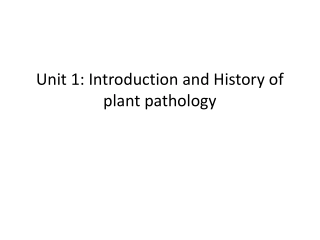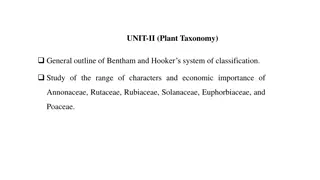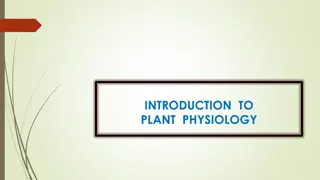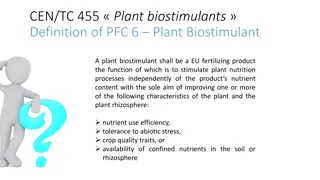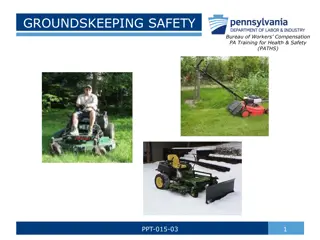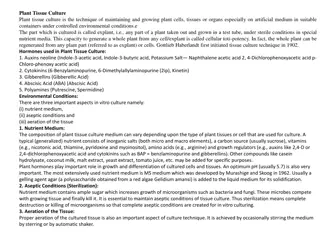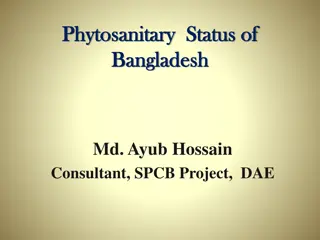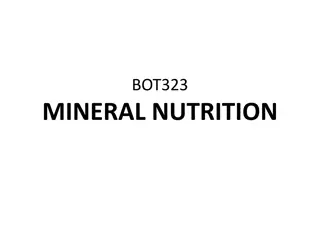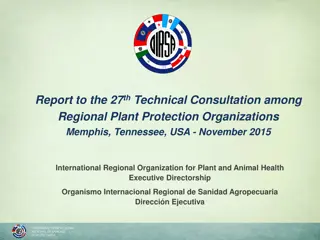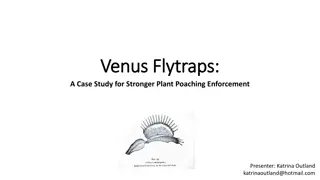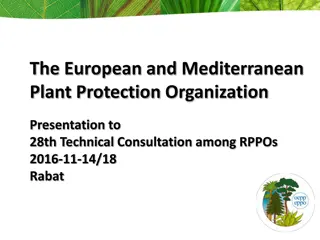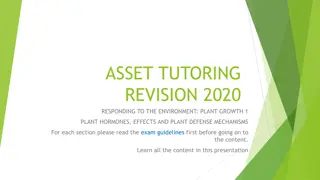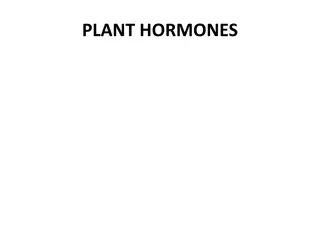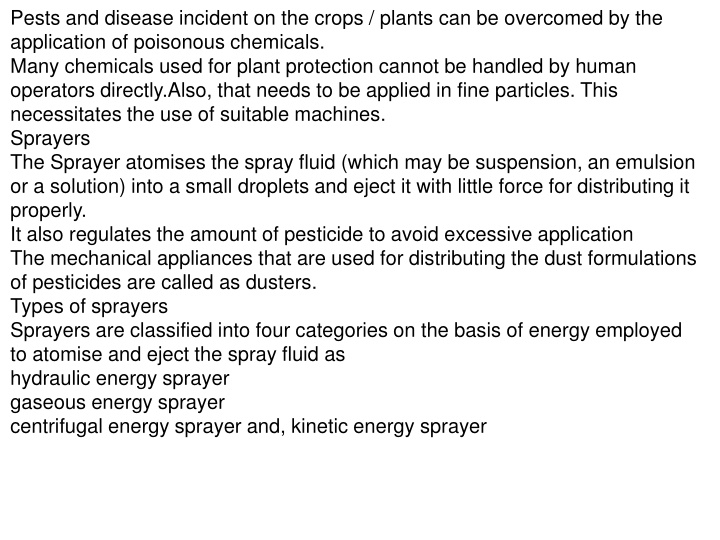
Effective Plant Protection: Understanding Sprayers and Dusters
Overcome pests and diseases on crops by using sprayers and dusters with poisonous chemicals. Learn about different types of sprayers such as hydraulic, gaseous, centrifugal, and kinetic energy sprayers as well as various manually operated dusters. Choose the right equipment for efficient application and distribution of pesticides.
Download Presentation

Please find below an Image/Link to download the presentation.
The content on the website is provided AS IS for your information and personal use only. It may not be sold, licensed, or shared on other websites without obtaining consent from the author. If you encounter any issues during the download, it is possible that the publisher has removed the file from their server.
You are allowed to download the files provided on this website for personal or commercial use, subject to the condition that they are used lawfully. All files are the property of their respective owners.
The content on the website is provided AS IS for your information and personal use only. It may not be sold, licensed, or shared on other websites without obtaining consent from the author.
E N D
Presentation Transcript
Pests and disease incident on the crops / plants can be overcomed by the application of poisonous chemicals. Many chemicals used for plant protection cannot be handled by human operators directly.Also, that needs to be applied in fine particles. This necessitates the use of suitable machines. Sprayers The Sprayer atomises the spray fluid (which may be suspension, an emulsion or a solution) into a small droplets and eject it with little force for distributing it properly. It also regulates the amount of pesticide to avoid excessive application The mechanical appliances that are used for distributing the dust formulations of pesticides are called as dusters. Types of sprayers Sprayers are classified into four categories on the basis of energy employed to atomise and eject the spray fluid as hydraulic energy sprayer gaseous energy sprayer centrifugal energy sprayer and, kinetic energy sprayer
Hydraulic energy sprayer Here the spray fluid is pressurised either directly by using a positive displacement pump or an air pump to build the air pressure above the spray fluid in the air tight container. The pressurized fluid is then forced through the spray lance, which controls the spray quantity and pattern. Gaseous energy sprayer In this high velocity air stream is generated by a blower and directed through a pipe at the end of which the spray fluid will be allowed to trickle by the action of gravity through a diffuser plate. Centreifugal energy sprayer In this the spray fluid fed under low pressure at the centre of a high speed rotating device is atomised by centrifugal force as it leaves the periphery of the atomiser. The droplets are carried by the air stream generated by the blower of the sprayer Kinetic energy sprayer In Kinetic Energy Sprayer the spray fluid flows by gravity to a vibrating or oscillating nozzle which produces a coarse fan shaped spray pattern. This is used for application of herbicides.
Types of sprayers Depending on the source of power it can be classified as manually operated and power operated dusters. The manually operated dusters are (i) package duster (ii) plunger duster (iii) bellow duster and (iv) rotary duster. (i) Package dusters In some pesticide dusts are packed in containers that serve as a hand applicators and may discard after use. They are provided with rubber, leather or plastic section which, on getting squeezed, provides a puff of air that emits the dust in a small cloud. The simplest type of package duster is by pressing it between the fingers. (ii) Plunger dusters The consists of an air pump or dust chamber, and a discharge assembly consisting of a straight tube or a small exit pipe . discharge outlet can be increased or decreased by moving lid provided at the end of the dust chamber. The air from the pump is directed through a tube into the container where it agitates the dust and eject it from a discharge tube. The amount of dust can be controlled by the speed of the operation of the pump.These are useful for spot application in restricted areas and for controlling ants, poultry pest and pest of farm animals.
(iii) Bellow duster made from rubber, leather or plastic.On squeezing, it puffs the air that expels the dust in a small cloud. Hand held bellow duster has containers of capacity from 30 g to 500 g.They can be operated either directly by hand or by handle provided for that purpose. The knapsack duster has the container capacity of 2.5 to 5.0 kg. The air blast developed by the bellow draws the dust from the hopper and discharges through the delivery spout These dusters are suitable for spot treatments. (iv) Rotary duster consists basically of a blower complete with a gear box and a hopper. It is operated by rotating the crank. The cranking motion is transmitted through the gear box to the blower. This transmitts to dust agitator located in the hopper. They are hand carried type or shoulder mounted or belly carried type. The feed is controlled by a feed control lever, which operates a slide to control the aperture at the bottom of the hopper.
.v) Power dusters The resemble the rotary duster in construction, except that the power to drive the blower through the gear box is from an external power source which may be an engine or P.T.O. shaft of the tractor or flywheel of the power tiller. The power operated centrifugal energy knapsack sprayer can be converted into a power duster, by allowing the dust fluid into the air stream, near the point of attaching the pleated hose, in the blower elbow.
TYPES OF SPRAYERS Hand sprayer The hand sprayer is a small, light and compact unit. The capacity of the container varies from 500 to 1000 ml. This is generally used for spraying small areas like kitchen garden and experimental laboratory plots. It is a hydraulic energy sprayer. It has a hydraulic pump inside the container, with cylinder, plunger and a plunger rod. If the pressure to be built inside the container an air pump with cylinder, plunge and plunger rod is required. When the plunger is pulled up, the air is sucked into the cylinder and when pushed down the air bubble is releases into the container and filled with the fluid.The air reaches the space above the free fluid surface and presses the fluid. The pressurised fluid is drawn up through a downward stroke to the nozzle, where is atomized and sprayed.
The fluid is lifted through a capillary tube and sheared away by the air and sprayed as droplets. Knapsack sprayer Any sprayer which is carried on the back of the operator is called a knapsack sprayer. The commonly used manually operated knapsack sprayer will have one hydraulic pump working inside the container. The plunger works inside the replacement attached at the bottom of the container, for easier maintenance. The pump can be operated through the appropriate linkages by oscillating the handle, with the sprayer carried on the back. An agitator is present in the pressure chamber to agitate the fluid so that the particles in suspension will not settle down. A delivery tube is attached on the other end of the pump which carries the pressurises fluid to the spray lance. The flow to the nozzle is controlled by a trigger cut-off valve.
Rocker sprayer The rocking sprayer has a pump assembly, fixed on a wooden platform with an operating lever, a valve assembly with two ball valves, a pressure chamber, suction hose with strainer, and delivery hose with spray lance. When the plunger is pulled behind by pulling the lever way from the pump, the spray fluid from the container is sucked through the strainer and pushes the bottom ball valve above and enters the pump. When the lever is pushed towards the pump, the sucked fluid is forced to enter the pressure chamber by opening the upper ball valve. The operation is continued till the entire suction pipe, ball valve assembly, delivery hose and a portion of pressure vessel is fitted with spray fluid and pump operator finds it difficult to push piston forward, due to downward pressure developed by entrapped compressed air in the pressure vessel. Thereafter, the trigger cut off valve will be opened to allow the spray fluid to rush through the nozzle and get atomized. Usually 14 to 18 kg/cm2 pressure can be built in the pressure chamber and hence can be conveniently used for free spraying.
Bucket sprayer This is designed to pump spray fluid directly from, the open container, usually a bucket. The hydraulic pump will be put inside the bucked and held properly with the help of foot rest. As the plunger is pulled up, the fluid enters through the suction ball valve assembly and when the plunger is pressed down, the suction valve closes and the fluid enters the pressure chamber through a ball valve assembly. As the plunger is continuously worked, pressure is built in the pressure chamber and the delivery hose. As soon as the required pressure is built up, the spraying will be done. A pressure of 4 kg / cm2 is developed in most of the models. Foot sprayer This is a modified version of rocker sprayer. The pump is fixed in a vertical position with necessary braces.The plunger moves up and down when operated by the pedal. A ball valve is provided in the plunger assembly itself to allow the fluid to cross the plunger and getting pressurized in the pressure vessel.
During the upward motion of the piston fluid is sucked in and pressurized into the pressure vessel and during downward movement, the sucked fluid crosses the plungers and enter the pump. The pressure developed is about 17-21 kg/cm2. Power sprayer All the sprayers which impart the mechanical energy developed by an I.C. Engine, on the spray fluid before spraying is called as a power sprayer. The most commonly used type of power sprayer in India is a gaseous energy type knapsack sprayer. Engine of 1.2 to 3 hp capacity, the spray fluid tank and the petrol tank are fixed rigidly.A pleated hose is attached to the blower elbow to carry the high velocity air and at the end of that a shear nozzle is fixed to allow the spray fluid to trickle in from the spray fluid storage tank, with a valve control. In operation, the engine is started by keeping the unit on the ground and then carried by the operator. The blower sucks the air behind the backrest and forces it into pleated hose.
The valve of the shear nozzle is opened and discharged through the nozzle. The high velocity air shears off the droplets and atomizes by the impact of diffuse and delivers it on the plant the surface. The spray fluid tank capacity varies from 7 to 12 litres.The fuel tank capacity varies from 0.75 to 2.25 litres. The spray fluid discharge can be varied from 0.5 to 5 lit / minute. Battery or ULV sprayer ULV sprayer was invented as a result of the desire to reduce the quantum of chemical carried by the man for application and to eliminate the water as a medium to carry the chemicals. The basic requirements of ULV spraying areThe narrow and controllable droplet spectrum (100-250 m for fine sprayers, 50-100 m for mist sprayers and 0.1 to 50 m for aerosols)
The accurately controllable emission rate and The non-volatile pesticide formulation of suitable viscosity and density. The reduction in volume of the spray fluid decreases the time spent to recharge sprayer, in fetching water, in mixing the pesticide and filling the tank. In a day of 8 hour about 8 ha can be covered in ULV spraying against 3 ha with power sprayer. A battery operated ULV sprayer has a long handle at the horse power D.C. motor is fitted with a spinning disc and a cover. A HDPE bottle is fixed close to the motor, in such a way that spray fluid is allowed to trickle at the centre of the spinning disc in operation. Centrifugal energy imparted fluid comes out of the nozzle and atomizes. The hand held ULV applicators are so designed to release the spray droplets at 1 m away from the body of the operator. Further, it is recommended that they should be operated only when the spray cloud would be blown away from him by the breeze so as to minimize the risk of contamination. After spraying, the atomizer must be flushed with paraffin to remove the residual pesticide. Inefficient cleaning would leave the pesticide deposit in the feeder stem to completely of partially block the flow of the pesticide.

